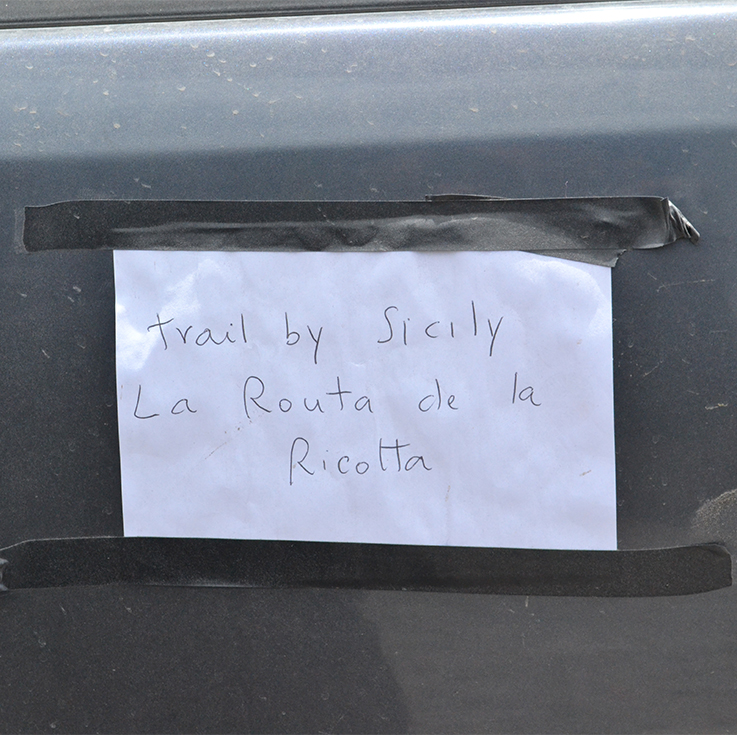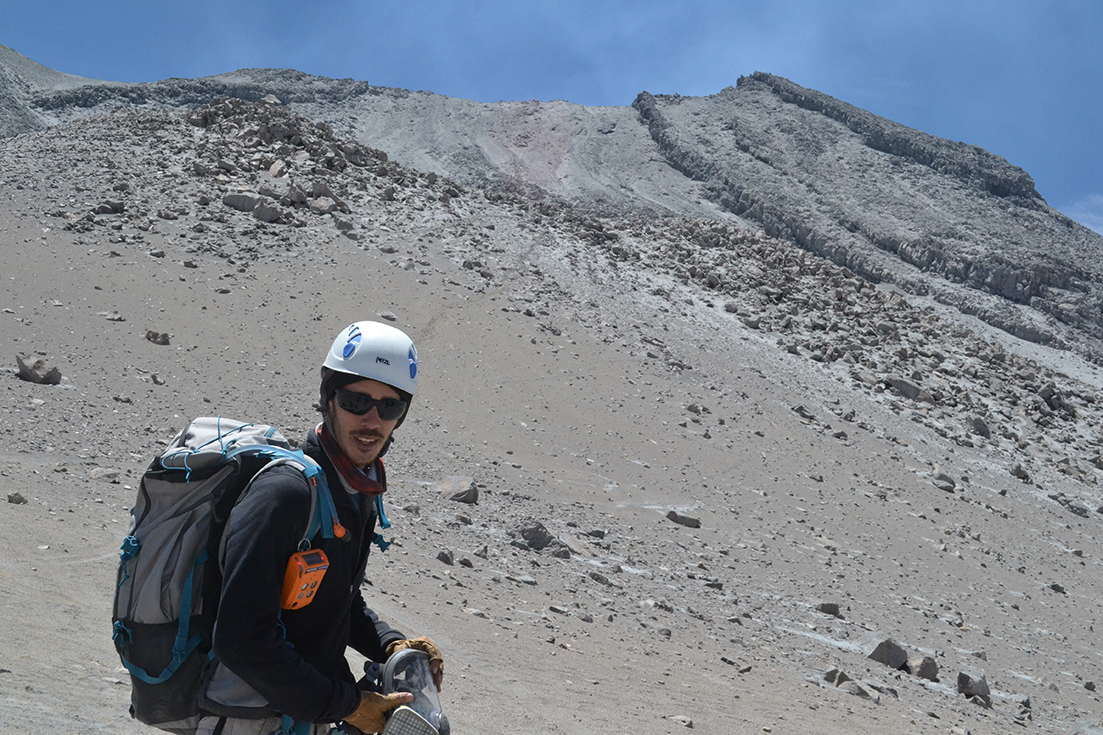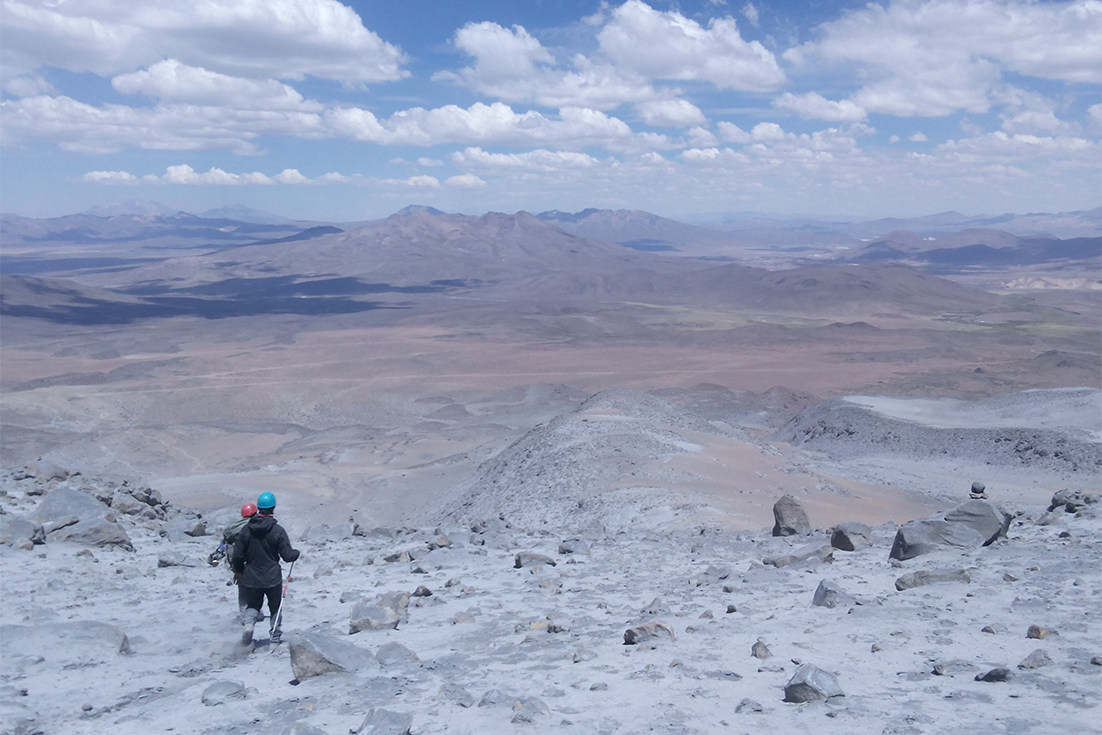Panorama of the summit crater at Volcán Ubinas (photo: Fredy Apaza)
Riding the Guallatiri high, we headed for Peru. We had aimed to be on Peruvian soil by noon, but it wasn’t long until Yves’ “facilitating” skills were put to the test. In fact, we were turned away once, and made a second attempt after diplomatic assistance from the incredible people at IRD. On the second try, border patrol scrutinized every nut and bolt in our load, with rules seeming to change by the minute. But after 6 hours of negotiations the team were in Peru!
Southern Peru is home to some of the most active volcanoes on the Trail By Fire. For this section, we had the honor of teaming up with local scientists from Peru’s OVI – INGEMMET, who run the volcano observatory in Arequipa. Fredy Apaza, Pablo Masias, and their many colleagues know the local volcanoes like the backs of their hands, and monitor their activity. They gave us a warm welcome at their Arequipa headquarters, and were willing to lead us through the Peruvian portion of the trip.
The other “Friends of Trail By Fire” to join in Arequipa were Alessandro Aiuppa (INGV, Palermo) and Giancarlo Tamburello (Universidad de Palermo), world-leading experts in volcanic degassing. They brought additional instruments and expertise – including another MultiGAS instrument, which importantly gives gas composition (ratios of different gas species) to complement the gas flux (amount of gas discharged per unit time) that can be obtained by UV Camera and DOAS.
Our Sicilians colleagues swiftly got in the spirit of “The Trail.” We formed a new and dynamic collaboration between The Trail By Fire and “The Trail by Sicily: La Routa de la Ricotta”!
Friends of the Trail By Fire
With the Friends of Trail By Fire assembled, and with the expert guidance of Fredy and his colleagues from OVI, we were ready to take on the formidable volcanoes of Peru, starting with Volcán Ubinas. Right from the start, the drive to Ubinas Village was sufficient to melt away all dark memories of bureaucratic trauma.
Volcán Ubinas is the most active volcano in Peru. A large (Volcanic Explosivity Index (VEI) 5 on a scale of 1 to 8), pumice-forming rhyolite eruption occurred as recently as ~1000 years ago. Historical records dating to the 16th century describe at least 24 eruptions, mostly relatively small magnitude (VEI < 2) explosive events. Eruptive activity at Ubinas is considered to be ongoing, with intermittent explosions occurring since March 2015. OVI continuously monitors seismicity, gas flux, and deformation at Ubinas, in order to determine hazards associated with its activity. At the time of writing, they list the volcanic alert level as “orange” on a four colour scale.
With the addition of our colleagues and with perfect weather, the Trail By Fire mobile volcano observatory was a veritable hive of scientific activity. Nial ran static and scanning DOAS systems. Ian ran the team’s UV Camera. Aaron performed test flights with the MultiGAS-equipped Matrix Quadcopter. Sandro and Giancarlo introduced their new UV Camera setup and provided expertise on implementation of the MultiGAS instruments.
On the final day of the campaign, the plume was fortuitously descending down the flanks of the volcano. Fredy, Yves, and Giancarlo donned helmets, gas masks, and portable gas detectors, and made a daring dash to the summit. At the crater rim, they used their MultiGAS instruments to measure the composition of gases emitted from Volcán Ubinas, for the first time.
As if the successful field campaign at Ubinas was not enough, back in the UK, Talfan “Eye in the Sky” Barnie had been liaising with Ashley Davies of NASA’s Jet Propulsion Laboratory to coordinate satellite observations with the Team’s work on the ground. At the same time as the field campaign, they captured thermal anomalies (hot spots) at Ubinas from the Earth Observing-1 spacecraft. Together, these provide a rich set of data from which to expand our understanding of the volatile composition and flux at this globally important, and highly active volcano.
The Earth Observing-1 (EO-1) spacecraft is managed by NASA's Goddard Space Flight Center, Greenbelt, Maryland. EO-1 is the satellite remote-sensing asset used by the EO-1 Volcano Sensor Web (VSW), developed by NASA's Jet Propulsion Laboratory, Pasadena, California, which is being used to monitor volcanic eruptions around the world. Image Credit: Ashley Davies
For the next couple of weeks, we we will continue to work closely with OVI and with the Trail By Sicily, our next stop being the mighty Volcán Sabancaya. May the Trail By Fire burn on!! And may the Trail by Ricotta continue to taste great with fresh pasta and carefully selected wine.












